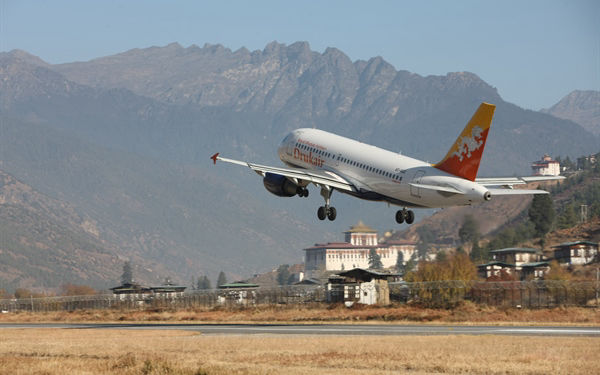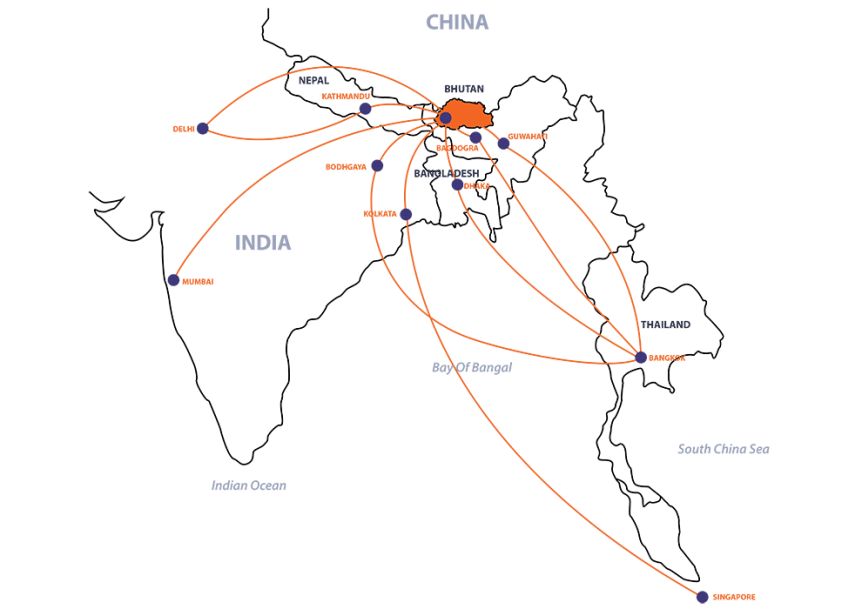Trip Planner
The Kingdom of Bhutan remained largely cut off from the rest of the world up until the early 1960’s. Entering the country was difficult as it was only accessible by foot from two main entry points, one in the North and another from the South. The Northern route was through Tibet, crossing high mountain passes that were inaccessible throughout the winters. The second entry route from the South came through the plains of Assam and West Bengal. The high frozen passes in the North and the dense jungles in the South made it extremely difficult to enter the country.
However, carefully planned economic development has made the country much more accessible and there are now a network of roads entering and traversing the country, as well as one international and multiple domestic airports.
Today the main roads entering the country are through Phuentsholing in the south, linking Bhutan with the Indian plains of West Bengal through the border towns of Gelephu, in the central region and Samdrup Jongkhar in the east, that link Bhutan with the Indian state of Assam.
Travel By Land
Phuentsholing, Gelephu and Samdrup Jongkhar are the only land border areas open to tourists.
The town of Phuentsholing in south-west is located approximately 170 km east of the Indian national airport at Bagdogra. After crossing Phuentsholing, you begin your journey to Thimphu, the capital city with travel time of about six hours for the 170 km stretch.
Gelephu, in south-central Bhutan, is another entry point to Bhutan. It is approximately 250 kms from Thimphu and the journey will take you through the sub-tropical areas of Bhutan before entering the alpine zone and then finally into Thimphu. One will have to traverse across three districts and the travel time will be about ten hours.
The district of Samdrup Jongkhar in south-east Bhutan borders the Indian district of Darranga, Assam and is approximately 150 kms away from Guwahati, the capital city of Assam. The journey from Guwahati is about three hours. Tourists entering Bhutan through Samdrup Jongkhar will take you to Trashigang, and from there over the lateral route to Mongar, Bumthang, Trongsa, Wangdue Phodrang and then finally into the capital, Thimphu. The distance is about 700 kms and will take you a minimum of three days to reach Thimphu.
Travel By Air
There are flights to destinations that include Bangkok, Delhi, Kolkata, Bagdogra, Bodh Gaya, Dhaka, Kathmandu, Guwahati, Singapore and Mumbai.
Paro is situated at a height of 2,225 m (7300 ft) above sea level and is surrounded by mountains as high as 4,876 m (16,000 ft). At present two carriers operate to Bhutan, Drukair and Bhutan Airlines. There are also domestic airports in Yonphula in eastern Bhutan, Bumthang in central Bhutan, and Gelephu in south-central Bhutan.
Flying into Bhutan’s Paro International Aiport is typically an exciting experience as the descent into Paro valley brings you closer to the mountain tops than most other flights in the world. The flight between Paro and Kathmandu is one of the most exciting ones as the aircraft passes over four of the five highest mountains in the world. In fine weather, as you soar higher up, you can enjoy the spectacular view of Mt. Everest, Lhotse, Makalu and Kangchenjunga at their best.
Do I need a visa to enter Bhutan?
Visitors of all nationalities, except those from India, require a visa before entering Bhutan. For all visitors, except those from Bangladesh and the Maldives, this visa must be applied for and approved in advance of travel. Visitors from Bangladesh and the Maldives also require a visa, but this can be applied for and approved either in advance of travel or upon arrival in Bhutan.
Visitors from India are able to apply for a permit but are required to hold an Indian passport or an Indian voter ID card. For Indian nationals under the age of 18, a passport or a birth certificate can be used to enter and they must be accompanied by a legal guardian.
Nationals from Switzerland and Thailand holding diplomatic or government-official passports are eligible for a visa at their port of entry.
How do I apply for a visa?
You can apply online for a visa here, or if you’re travelling with a tour operator, they may apply on your behalf. Read more about the visa here.
Visitors from Bangladesh and the Maldives requiring a visa can apply either online before travelling or in person upon arrival in Bhutan.
Are there any nationalities restricted from being granted a visa to enter Bhutan?
No, there are no restricted nationalities in Bhutan.
I’m an Indian national, or from Bangladesh or the Maldives. How can I obtain a travel permit or visa?
Before travelling, visitors from India, Bangladesh and the Maldives can apply for a permit (Indian nationals) or visa (Bangladeshi or Maldivian nationals) here. You may also apply at the point of entry, but please be aware that there may be a long wait depending on the number of applicants at the time. We recommend arranging your permit/visa beforehand.
A wide variety of accommodation is available ranging from luxurious 5-star hotels to cozy little hotels and homestays in traditional Bhutanese homes and settings. Visitors can be assured of their warmth and comfort of the hotels. Similarly, the ambiance and hospitality offered by the hotels are incredible.
The types of accommodations can be divided into:
1. Hotels
2. Resorts
3. Farm-stays
4. Home-stays
Additionally visitors embarking on long treks will be provided with tents and whatever other camping equipment is deemed necessary. Regardless of where they stay, visitors can be assured of their comfort and traditional Bhutanese hospitality.
Hotels
Hotels in Bhutan are rated according to a National ....5 Star rating System. All Tour Operators are ....required to provide their guests with a minimum ....of 3 Star accommodations so you can be assured ....of your comfort. Most hotels provide their guests ....with Television, Room Service, Fitness Centers, ....Spas and Wi-fi. However the exact services ....available will vary from hotel to hotel.
....In order to ensure that all visitors to Bhutan ....receive high quality accommodations and services ....we have initiated a 5-Star Rating System that ....classifies the various hotels and resorts operating ....in the country.
The system is referred to as the ‘Hotel Star System’ and it ranks the accommodations on a scale of 1-5 stars based on an exhaustive set of criteria.

